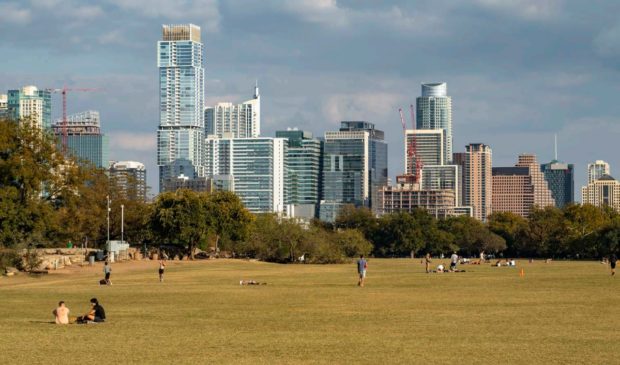Vision plan authors hope for a more sustainable future for Zilker
Wednesday, December 21, 2022 by
Nina Hernandez The current state of Zilker Park, from an ecological perspective, is about what you would expect for a 100-plus-year-old metropolitan park in a city with a population just shy of 1 million. With 2.6 million visitors enjoying nature and amenities in the park each year, Zilker is in dire need of the more than 91 acres of ecological uplift proposed in the city’s new vision plan.
During a recent public engagement meeting, community members raised concerns about the environmental implications of the plan and what it will mean for park users.
According to Haley Wagoner with ecological consultant firm Siglo Group, the results will be a greener, more comfortable park that reflects our natural Central Texas landscape and will be able to hold up to human use in a more sustainable way.
It hasn’t been the focus of the public discourse, but the 351-acre park is facing a series of ecological challenges at present. One of the more glaring is the erosion of Barton Creek, particularly the area adjacent to Barton Springs Pool that’s known as Barking Springs. Over time, a combination of unmanaged stormwater and human disturbance created an eroded bank leaving exposed tree roots vulnerable to damage from swimmers.
Then there’s the Butler Landfill along Lady Bird Lake and the West Butler Landfill the city is currently using as a junkyard to store various environmental hazards, including asphalt, electric powered carts, small vehicles with lead-acid batteries, surplus lawn-maintenance equipment, and chemical containers without covers. The landfill and the Polo Field are both considered degraded, having been used for parking, construction laydown sites and setup areas for Austin City Limits, as well as overflow parking for other major events.
Perhaps the biggest ecological threat facing Zilker is invasive species. Introduced from other countries or regions, non-native species cause ecological harm by altering soil chemistry, displacing native plants and animals, and changing the light in and around the canopy, which can have impacts on insects and animals by interfering with their food, shelter and protection.
Over the course of the plant survey, the team recorded 70 non-native species in Zilker, with 38 of those considered invasive due to their aggressive growth and spread. The vision plan calls for mitigating those species and replacing them with species native to Central Texas. That biodiversity is important as the region grapples with the impacts of climate change.
Proponents of the plan worry that if the city doesn’t take action, the erosion of lower Barton Creek could become so severe it leads to trees – already vulnerable – becoming so unstable they fall into the creek. The plan calls for the restoration of the banks and the now-degraded slope. The city will identify areas where visitors can access the water, and between those areas will start restoring the banks by replacing the soil.
The plan also calls for the ecological uplift and remediation of contaminants at the Butler Landfill, and reports that it could add up to 17 acres of plant and wildlife habitat that could also be enjoyed by park visitors. The West Butler Landfill, formerly the “Boneyard,” should be eliminated as soon as possible because of the potential hazard.
Questions continue to swirl over the proposed 2,500 parking spaces over three garages, including underground, proposed in the plan. Claire Hempel, principal with urban design consulting firm Design Workshop, acknowledged the dilemma faced by the 17-member planning team.
“We’re having to investigate and solve for a lot of the challenges that people experience today but also looking forward for the next 50 years,” she told the Austin Monitor. “A lot of people who are coming to Zilker are arriving by car.”
She pointed to the accommodations for alternative modes of transportation in the plan, as well as the investment the city is making in the form of Project Connect. The city is also piloting shuttle programs that may be implemented more widely in the future. The plan notes that some of the new parking may be converted back into park use in a future in which Austinites are less dependent on cars.
In terms of the environmental impacts of the garages, Hempel noted that the site near MoPac Expressway is already impacted by the highway. The second garage, which would be two stories underground, would improve access to the Zilker Botanical Garden as well as to a key shuttle shop. The third potential site is near the Umlauf Sculpture Garden. Many of its visitors currently park at Zilker.
The plan would remove surface parking that takes place at the landfill and Polo Field today, and eliminate much of the idling that happens as cars wait to park along Azie Morton and Lou Neff roads.
“We are recognizing the reality of car use today, particularly for people who do not live nearby,” Hempel said, “and better distributing those spaces in the park to where it marries with internal circulation and better connected trails and pathways for bikes and walkers to get around.”
The Save Our Springs Alliance raised concerns about the plan, including the parking elements and lack of provisions for Barton Springs. However, not every community group is against the proposal.
The Zilker Collective Impact Working Group is a coalition of 16 organizations and businesses, including the Barton Springs Conservancy, Austin Parks Foundation and The Trail Conservancy, that operate in or adjacent to Zilker Park. The group formed in 2021 to provide feedback to the planners, and its project manager, Karen Blizzard, said they are thus far satisfied with the results.
“We were really impressed with just the breadth of ecological uplift that is in the plan,” Blizzard said.
Mike Cannatti, board chair of the Barton Springs Conservancy, pointed to the parking footprint remaining the same even as spaces would slightly increase. “They’ve achieved it with a lot less impervious cover,” he said.
Wagoner also points out that the garages themselves, as well as the areas reclaimed by removing lanes from Barton Springs Road, can be areas for the city to plant native species and reclaim habitat. It’s all building toward a future where people can interact with the ecology around them without degrading it.
Cannatti addressed SOS criticism that the plan didn’t do enough for its neighbor, Barton Springs Pool. The conservancy board chair said the Zilker plan intentionally refrained from “re-planning” the pool area, because the future stewardship of Barton Springs is already in place with the Barton Springs Pool Master Plan.
In addition to the uplift, Blizzard noted the proposed visitor hub near Barton Creek where people can understand the area’s natural resources. Hopefully that means future generations won’t repeat the mistakes of Austin’s past.
“That’s just a win-win,” she said. “If you’re informing the public, that ultimately creates stewards who want to care for the resource.”
The Austin Monitor’s work is made possible by donations from the community. Though our reporting covers donors from time to time, we are careful to keep business and editorial efforts separate while maintaining transparency. A complete list of donors is available here, and our code of ethics is explained here. This story has been changed since publication to correct the name of The Trail Conservancy, which was originally refered to as its previous name.
You're a community leader
And we’re honored you look to us for serious, in-depth news. You know a strong community needs local and dedicated watchdog reporting. We’re here for you and that won’t change. Now will you take the powerful next step and support our nonprofit news organization?











